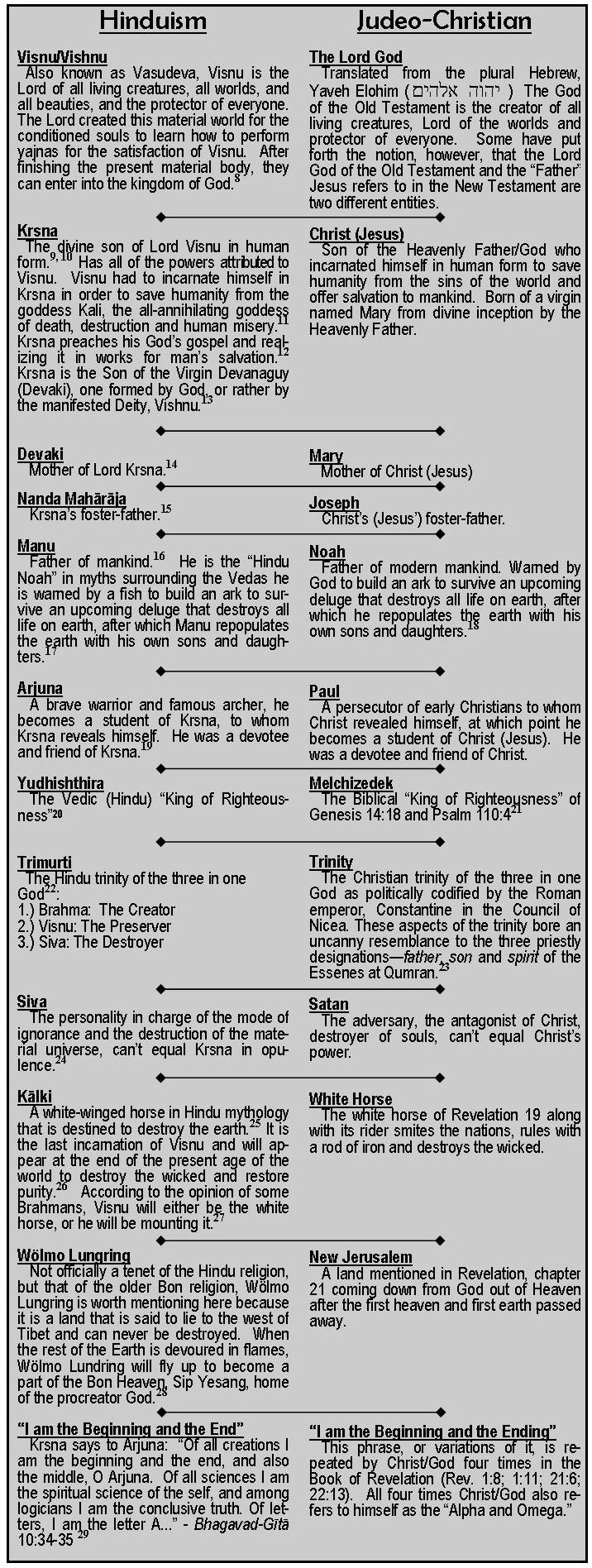Judeo-Christian/Hinduism Parallels

By: David Deschesne
Editor/Publisher, Fort Fairfield Journal
March 16, 2016
Most Christians today go to church on Sunday (or Saturday), listen to a pastor or priest teach the same old doctrine and tradition, then go home and wait another seven days for another dose. In between times they may study their Bible, but rarely will a Christian stray outside the box and investigate other religions, for fear of being burned for eternity in hell.
While I currently ascribe to the Christian faith (in its original form, not the perverted form perpetuated by today’s modern, commercialized church ‘christiantainment’ venues), I have investigated other religions and have been intrigued by the many stories and ideas from those religions, which predate Christianity, that appear to have somehow been grafted on to Christianity. You won’t find this research presented at any establishment Christian church, or hear it from any hyperventilating television preacher, because it would be deemed too ‘heretical’ and place them at risk of losing precious tithe-paying followers.
As a religious belief system, Hinduism dates its sacred writings—the Vedas—back nearly 4,000 years.1 They have also been presumed to date as far back as 2,400 B.C. Historian Max Muller suggests certain difficulties in this chronological computation, but does not altogether deny it.2 By contrast, the Christian Bible’s Old Testament, which also shares some parallels with the Hindu Vedas, only goes back to around 1,000 B.C.—or 1,000 years or more after the Vedas were written—and at that the oldest books were passed down orally3 for hundreds of years before being committed to writing. While authorship of the first five books of the Old Testament (the Torah) is generally attributed to Moses, who lived in the 13th century B.C., he had nothing to do with the writing of the complete Torah. His name was attached to it as author at the time of the book’s canonization.4 The version of the Old Testament Torah Christians use today is from the Masoretic text which took the oral tradition and written scrolls and began to preserve it in writing starting around 600 A.D.5 The books of the Christian New Testament, with its similarities to Hindu characters began to be composed around 50—100 A.D., or around 2,000 years after Hinduism’s Vedic literature and 400 years after the earliest Vedic writing, the Bhagavad-Gītā was interpolated in its present form.6
Hinduism, and its offshoot, Buddhism, originate from ancient Tibet where the religion before them was one called Bon.7 Hinduism now has probably as many different sects and belief systems dividing it as the Protestant Christian religion does today. With that said, however, there are many similarities that all flavors of Hinduism are in general agreement with. These characters and ideas are what will be discussed here.
In this study, I am going to look at Hinduism and some of its characters’ and ideas’ many similarities to the much later religions of Judaism and Christianity. I am not making any overt assertions here one way or the other. I merely present this information to you the way I have researched and understand it. It is then up to you to decide what to do with it.
Click on this image to enlarge and clarify the text in your photo viewer, if needed.
Click on this image to enlarge and clarify the text in your photo viewer, if needed.
Notes:
1.) Hinduism, R.C. Zaehner, ©1987 Oxford University Press, p. 3
2.) Isis Unveiled Vol. 2, 1877 Helena Blavatsky, 2008 Forgotten Books version, p. 432
3.) The Torah: A Modern Commentary, W. Gunther Plaut, ed., ©1981 Union of American Hebrew Congregations, p. XVIII
4.) op. cit. p. XXIII
5.) The New Encyclopedia of Judaism, ©2002 Jerusalem Publishing House, p. 509.
6.) Encyclopedia Britannica, 1958 ed. Vol 12., p. 183.
7.) Funk & Wagnall's Standard Dictionary of Folklore, Mythology, and Legend, ©1972 Harper & Row, p. 154
8.) Bhagavad-Gītā: As it is, A.C. Bhaktivedanta Swami Prabhupāda, ©1972 Bhaktivedanta Book Trust, p. 48
9.) Bhagavad-Gītā: As it is, p.169
10.) Encyclopedia Britannica, 1958 ed. Vol 2., p. 792.
11.) Isis Unveiled Vol. 2, p. 274
12.) Encyclopedia Britannica, 1958 ed Vol. 13, p. 503
13.) Isis Unveiled Vol 2., p.273
14.) Bhagavad-Gītā: As it is, p.188
15.) Bhagavad-Gītā: As it is, p. 289
16.) ibid
17.) Encyclopedia Britannica, 1958 ed, Vol. 14, p. 830
18.) Genesis, chapters 6 - 10.
19.) Bhagavad-Gītā: As it is, p. 287
20.) Hinduism, p. 13
21.) see Strong’s #4442, צדק מלכּי - “king of right”
22.) Hinduism, p. 86
23.) Bloodline of the Holy Grail, ©1996 Laurence Gardner, p. 116
24.) Bhagavad-Gītā: As it is, pp. 17, 290
25.) Encyclopedia Britannica, 1958 ed, Vol. 2, p.792
26.) Funk & Wagnall's Standard Dictionary of Folklore, Mythology, and Legend, p. 568
27.) Isis Unveiled Vol 2., p.273
28.) The Diamond Path: Tibetan and Mongolian Myth, ©1998 Time-Life Books, p. 29
29.) Bhagavad-Gītā: As it is, p. 173










